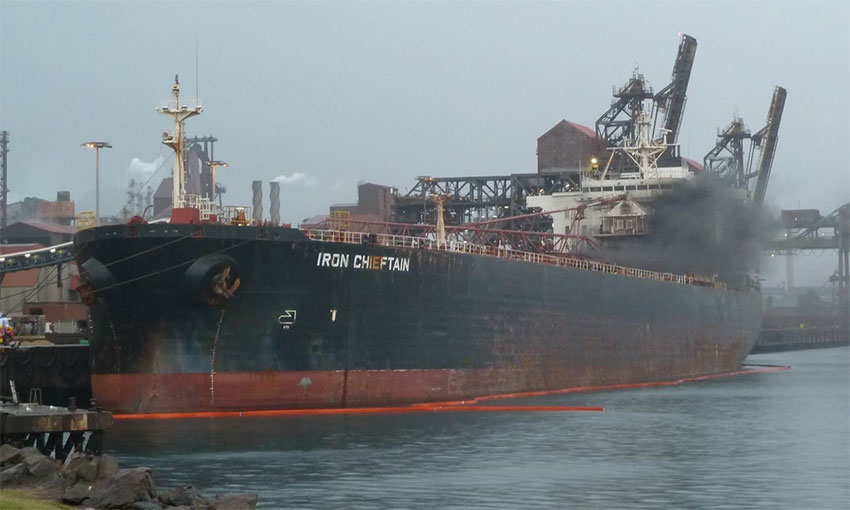THE FIRE that raged on the Iron Chieftain for five days at Port Kembla in June 2018 brought to light inadequate standards for self-unloading bulk carriers, according to a report on the incident from the Australian Transport Safety Bureau.
The bureau’s investigation found dedicated fire detection and fixed fire-extinguishing systems were not fitted in the self-unloading system spaces, and they were not required to be.
This lack of international standards and regulations around fire detection and extinguishing systems “greatly reduced the opportunity for the fire to be detected and extinguished early”, the report said.
The incident
The 202-metre, Australian flagged self-unloading bulk carrier was at Port Kembla in the early hours of 18 June 2018 when the fire started.
Friction, probably from a failed bearing, generated enough heat to ignite a rubber conveyor belt in the C-loop internal cargo-handling space.

During a regular safety round of the self-unloading system during cargo discharge operations, a crew member detected a strange smell and white smoke. The smoke abruptly changed to black as the crew member approached the deck casing door for the C-loop space.
The ship’s crew then initiated an emergency response. But shipboard efforts to control the fire proved ineffective. The fire soon established itself and spread to the exterior of the ship, setting the discharge boom alight.
The ship was eventually evacuated. Fire and Rescue New South Wales (FRNSW) firefighters took charge of the response to the fire. The fire was contained and extinguished about five days later.
The fire caused substantial structural damage including breaches of two fuel oil tanks. Much of the self-unloading system was destroyed.
The ship was subsequently deemed uneconomic to repair and declared a constructive total loss. It was towed to Turkey for recycling.
There were no serious injuries or marine pollution reported as a result of the fire.
The findings
ATSB Chief Commissioner Greg Hood said the fire onboard the ship demonstrates how the effectiveness of a shipboard response to a fire depends primarily on the ability to detect the fire at an early stage and quickly extinguish it at the source.
“Iron Chieftain’s self-unloading system was not equipped with a fire detection or fixed fire-extinguishing system in the C-loop space, but nor was it required to be,” Mr Hood said.
“This highlights the lack of adequate international standards or regulations for dedicated fire detection and fixed fire extinguishing systems in cargo handling spaces of self-unloading bulk carriers.”
The ATSB’s investigation report also notes that the initial emergency response by the crew – in particular stopping the conveyor belts – aided the fire’s early development, as heat could not dissipate.
“Following ignition, the combination of high fuel loads in the form of rubber conveyor belts in the C-loop space and airflow from the vertical design of the loop and its ventilation fans meant the fire quickly established itself and travelled along the C-loop’s rubber conveyor belt system to the ship’s exterior to the deck discharge boom and set it alight,” Mr Hood said.
In addition, heat from the fire in the C-loop space caused thermal stress. This cracked and deformed the adjacent heavy fuel oil tanks and released additional fuel for the fire, increasing its intensity and complexity.
“The ATSB recommends the introduction and improvement of international standards for suitable fire detection and fixed fire-extinguishing systems in the cargo handling spaces of self-unloading bulk carriers and the introduction of standards for the fire resistant properties of their conveyor belts,” Mr Hood said.
“The absence of these measures has been a contributing factor in at least three major shipboard fires over a 25‑year period, including Iron Chieftain.”
Mr Hood said the ATSB welcomes the commitment by the Australian Maritime Safety Authority and Lloyd’s Register to approach the International Maritime Organization and the International Association of Classification Societies, respectively, to highlight the safety issue regarding the inadequacy of fire safety standards or regulations for self-unloading system spaces.
“Nonetheless, the ATSB is recommending that AMSA formally raise the safety issue with the IMO to initiate safety action aimed at addressing the risk of fire in the cargo handling spaces of self-unloading bulk carriers due to the inadequacy of the current associated standards and regulations,” Mr Hood said.
Fire risk identified; adequate measures not put in place
Separately, the investigation notes that the operators of Iron Chieftain had identified the fire risk in the ship’s cargo handling space due to the lack of fire detection and fixed extinguishing systems – particularly in the C-loop space – about five years earlier. However, the prevention and recovery measures the operators put in place were not sufficient to mitigate the risk.
In response to the Iron Chieftain fire, the operator’s parent company, the CSL Group, initiated a fire risk mitigation project across its global fleet of self-unloading bulk carriers to improve fire detection and suppression technology, reviewing its firefighting policy and setting minimum fire safety standards for early fire detection and suppression at the ship design and build stage.
Finally, the ATSB also identified a safety issue relating to Fire and Rescue New South Wales’s marine firefighting capability as well as other safety factors related to the inconsistent conduct of ship’s drills and Port Kembla’s emergency response plans.
The full 86-page report can be found on the ATSB’s website.

